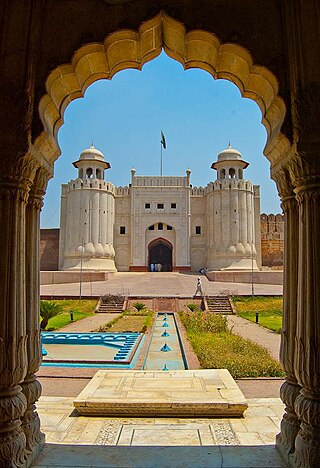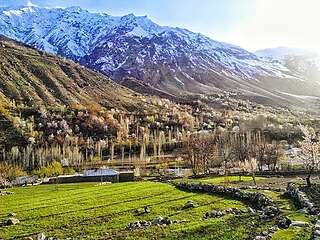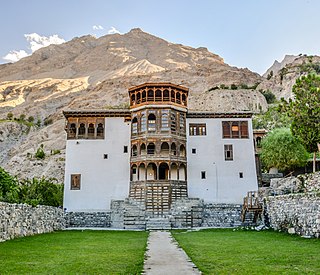
Khyber Pakhtunkhwa, formerly known as North West Frontier Province (NWFP), is a province of Pakistan. Located in the northwestern region of the country, Khyber Pakhtunkhwa is the fourth largest province of Pakistan by land area and the third-largest province by population. It is bordered by the Pakistani provinces of Balochistan to the south, Punjab to the south-east, the territory of Gilgit-Baltistan to the north and north-east, Islamabad Capital Territory to the east and Azad Kashmir to the north-east. It shares an international border with Afghanistan to the west. Khyber Pakhtunkhwa has a varied landscape ranging from rugged mountain ranges, valleys, plains surrounded by hills, undulating submontane areas and dense agricultural farms.

Islamabad is the capital city of the Islamic Republic of Pakistan. It is the country's ninth-most populous city with a population of over 1.2 million people and is federally administered by the Pakistani government as part of the Islamabad Capital Territory. Built as a planned city in the 1960s and established in 1967, it replaced Karachi as Pakistan's national capital.

Rawalpindi is the third-largest city in the Pakistani province of Punjab. It is a commercial and metropolitan city, being the fourth most populous in Pakistan. It is located near the Soan River in north-western Punjab, and is the third-largest Punjabi-speaking city in the world. Rawalpindi is situated adjacent to Pakistan's capital Islamabad, and the two are jointly known as the "twin cities" because of the social and economic links between them.

Skardu is a city located in Pakistan-administered Gilgit-Baltistan in the disputed Kashmir region. Skardu serves as the capital of Skardu District and the Baltistan Division. It is situated at an average elevation of nearly 2,500 metres above sea level in the Skardu Valley, at the confluence of the Indus and Shigar rivers. The city is an important gateway to the eight-thousanders of the nearby Karakoram mountain range. The Indus River running through the region separates the Karakoram from the Ladakh Range.

Murree is a mountain resort city, located in the Galyat region of the Pir Panjal Range, within the Murree District of Punjab, Pakistan. It forms the outskirts of the Islamabad-Rawalpindi metropolitan area, and is about 30 km (19 mi) northeast of Islamabad. It has average altitude of 2,291 metres (7,516 ft). The British built this town during their rule to escape the scorching heat in the plains of Punjab during the summer.

Northern Pakistan is a tourism region in northern and north-western parts of Pakistan, comprising the administrative units of Gilgit-Baltistan, Azad Kashmir, Khyber Pakhtunkhwa, Islamabad Capital Territory and the Rawalpindi Division in Punjab. The first two territories are a part of the wider Kashmir region. It is a mountainous region straddling the Himalayas, Karakoram and the Hindu Kush mountain ranges, containing many of the highest peaks in the world and some of the longest glaciers outside polar regions. Northern Pakistan accounts for a high level of Pakistan's tourism industry.

Deosai National Park is a high-altitude alpine plain and national park located between the Skardu District and Astore District in Gilgit-Baltistan, Pakistan.

Tourism in Pakistan is a growing industry. In 2010, Lonely Planet termed Pakistan "tourism's 'next big thing'". The country is geographically and ethnically diverse, and has a number of historical and cultural heritage sites. Condé Nast Traveller ranked Pakistan The Best Holiday Destination for 2020 and also declared it the third-highest potential adventure destination in the world for 2020. As security in the country improves, tourism increases; in two years, it has increased by more than 300%.

Chitral Gol National Park is one of the National Parks of Pakistan. It is located in Lower Chitral District in Khyber-Pakhtunkhwa province of Pakistan beside the Chitral River, at a distance of two hours drive from Chitral town. The park is also known as Chitral National Park.
Tajiks in Pakistan are residents of Pakistan who are of Tajik ancestry. The Tajiks are a Persian-speaking Iranian ethnic group native to Central Asia, living primarily in Afghanistan, Tajikistan, and Uzbekistan.

Garam Chashma is one of the many branch valleys of Chitral District, situated in the extreme north-west of Pakistan. It is one of the highest human settlements in the Hindukush ranges with an altitude of almost 2550 meters. The place is known for its hot spring, which is one of the tourist attraction sites. It is also famous for its trout fish. The water flowing down through the length of the valley is famous for fishing sports. The Lotkoh River running down from the lofty peaks of the Hindu Kush is most suitable for the brown type of trout fish. Other features of the area include snow-covered peaks, pleasant weather, and natural springs, and more recently, has remained in the limelight for being a potential site of hydropower generation. Besides tourists, people suffering from skin diseases also visit the hot spring for treatment. It is located in the northwest of Chitral at a distance of about forty-eight kilometres by road. It shares international borders with Afghanistan being situated in the extreme northwest of Pakistan. Dorāh Pass connects this part of Pakistan with Badakhshan, the adjacent province of Afghanistan.

Khaplu Palace, locally known as Yabgo Khar, is an old fort and palace located in Khaplu, a city in Gilgit-Baltistan, Pakistan. The palace, considered an architectural heritage site and a significant tourist attraction, was built in the mid-19th century to replace an earlier-dated fort located nearby. It served as a royal residence for the Raja of Khaplu.
Masood ul-Mulk TI is a Pakistani expert on humanitarian aid and a development practitioner. He is the CEO of SRSP the largest NGO working to alleviate poverty in North-West Pakistan.

Shahzada Mohiuddin was a Pakistani politician, a Federal and Provincial Minister, and Member of the National Assembly of Pakistan. He served as Minister of State for Tourism and Chairman National Assembly Standing Committee on Kashmir Affairs and Northern Areas. He was the grandson of Sir Shuja ul-Mulk. His eldest son Shahzada Iftikhar Uddin was elected as the MNA from Chitral in 2013.
The Sarhad Rural Support Programme (SRSP) is the largest non-governmental organization working to alleviate poverty in North West Pakistan. It was established in 1989 with the aim of reducing poverty and ensuring sustainable means of livelihood in what is now Khyber Pakhtunkhwa, Pakistan. SRSP is part of the Rural Support Programmes (RSP's) initiated by United Nations Environment Programme Global 500 Award winner Shoaib Sultan Khan. It is now the largest regional RSP, with extensive outreach into communities. In recent years because of its vast outreach, SRSP has had to play a prominent role in disasters that have hit Khyber Pakhtunkhwa. As a result, humanitarian work along with development has become a core competency of the organization.
Madaklasht is a valley located in Lower Chitral district, Khyber Pakhtunkhwa, Pakistan. The valley is predominantly inhabited by the Tajik people who speak Madaklashti, a dialect of Persian.

Chitral or Chitrāl was a princely state in alliance with British India until 1947, then a princely state of Pakistan until 1972. The area of the state now forms the Upper and Lower Chitral Districts of the Khyber Pakhtunkhwa, Pakistan.














